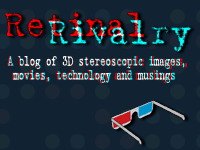- Eric Kurland: Shooting 720p 3-D with two Canon T-X1 Consumer Cameras
- Celine Tricart: Stereoscopic Storytelling
- Alexander Lentjes: Creating a 3D Homage to Bad Films
- Eric Deren: Shooting 3D Video in Freefall
- Sean Isroelit and Jeff Amaral: Producing 3D with High Tech Tools and Talents
- Jo Eldoen and Karl Bryhn: Creating Abstract CG Animation on the Z-Axis
- John Hart: Shooting Time-Lapse 3D Movies with Digital Still Cameras
- Ryan Suits: Shooting Black Light in 3D
- Santiago Caisedo: Inventing 3D Movies from Mixed Toolsets
- Stephen Les: Editing with Cineform Neo3D
- Takashi Sekitani: Getting Creative with Canine POV and Hyperstereo in 3D
- Zoe Beloff: Creating Apparitions in 3D
- Bernard Mendiburu and Eric Kurland: The World’s First 720p
- International Skype 3D
- Tommy Tripodes: Building a 3D System in Film School
- Tom Koester: Doing It All in 3D
- Ray Zone: Making 3D Movies with a Stereo Club
- John E. Hart: Jesting with Urban Legends in the Short 3D Film
- Ron Labbe: From the Computer Monitor to the Giant Screen
- Phil McNally: Making a Short Film to Get a Job in Hollywood
- John Rupkalvis: Making 3D Camera Systems Smaller
- Perry Hoberman: Performing and Inventing 3D
- Stephen Gibson: Shooting and Finishing a 3D Feature Film on the Desktop
- Al Razutis: A Complete 3D Artist
I recently joined Ray Zone and Perry Hoberman on a panel about independent 3-D at the National Association of Broadcasters (NAB) convention in Las Vegas. We presented clips from a number of our short films, and discussed the growing possibilities for personal 3-D production, post-production and distribution, as well as affordable emerging technologies for 3-D presentation and interactivity. We were very well received, and the audience’s positive response showed that there is a great deal of interest within the film and TV industry in stereoscopic content creation outside of the studio system. I have just launched a 3-D YouTube channel to present some of the great 3-D work that is being done by independent artists at the forefront of the 3-DIY movement. Check it out at www.3-DIY.net


No comments:
Post a Comment